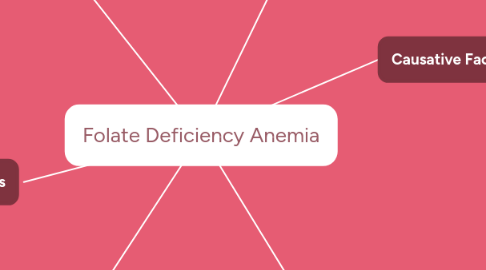
1. Pathophysiologic Etiology
1.1. Megaloblastic anemia: decreased RBC production,
1.1.1. Folate is an enzyme needed for DNA and RNA synthesis and nuclear maturation
1.1.1.1. Folate is required for thymine and purine synthesis, and homocysteine to methionine conversion
1.2. Megaloblasts mature into large erythrocytes (macrocytes)
1.3. Apoptosis of erythroblasts can occur in late stages of erythropoiesis
2. Causative Factors
2.1. Folate nutritional deficiency: inadequate diet
2.1.1. Fad diets or low vegetable intake
2.1.2. 50 to 200 mcg daily intake requirement of folate for humans, absorbed in upper small intestine then stored in the liver
2.1.3. Deficiency in vitamin C can contribute to folate deficiency anemia
2.1.4. Folate is also called also called vitamin B9 or pteroylglutamic acid
2.1.5. Found in dark green leafy vegetables and liver
2.1.6. Folic acid is the synthetic form
2.2. Impaired absorption
2.3. Intrinsic intestinal disease
2.4. Increased folate loss
2.5. Increased hematopoiesis
3. Risk Factors
3.1. Alcoholism
3.1.1. Interferes with folate metabolism in the liver
3.2. Medications: anticonvulsants, oral contraceptives, methotrexate
3.3. Pregnancy or lactation
3.4. Disseminated cancer
3.5. Hemodialysis
3.6. Gastric bypass surgery
4. Diagnostic Tests
4.1. CBC and blood smear
4.1.1. ●Anemia ●Macrocytic RBCs ●Mild leukopenia and/or thrombocytopenia ●Low reticulocyte count ●Hypersegmented neutrophils on the peripheral blood smear
4.2. Question celiac, inflammatory bowel disease, surgery, dietary intake, alcohol use
4.3. Serum folate level
4.3.1. ●From 2 to 4 ng/mL – Borderline: patient may need additional testing ●Below 2 ng/mL – Low: indicates folate deficiency
4.4. Methylmalonic acid (MMA) and homocysteine levels:
4.4.1. MMA normal, homocysteine elevated – Indicates folate deficiency

